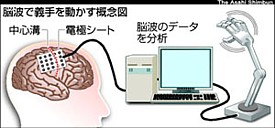
Elfoid -- a REAL android phone
Robotics researchers from Osaka University have teamed up with NTT Docomo and Qualcomm to develop a handheld humanoid phone that brings a new dimension to mobile communications. A prototype of the device -- called "Elfoid P1" -- was unveiled at a presentation in Tokyo on March 3.

The Elfoid phone is a miniature version of the Telenoid R1 robot developed last year by a research team led by Osaka University professor Hiroshi Ishiguro. The current prototype measures 20 centimeters (8 in) long, is covered in a soft fleshy urethane skin, and has the same genderless and ageless appearance as the Telenoid. The control buttons are embedded in the chest, which glows green when the Elfoid is in use.

Dr. Ishiguro with Telenoid and Elfoid [Photo by: eSeL.at]
Like the full-sized Telenoid robot, the Elfoid handset is designed to add an element of realism to long-distance communication by recreating the physical presence of a remote user.

[Photo: Ars Electronica]
Equipped with a camera and motion-capture system, the Elfoid phone will be able to watch the user's face and transmit motion data to another Elfoid phone, which can then reproduce the face and head movements in real-time.

[Photo by: d_&_r]
The current prototype is unable to move, but future versions will incorporate tiny motors and parts made from shape-memory alloys, allowing the Elfoid to move its eyes, mouth, neck and arms. Other features will include a temperature sensor, accelerometer, and an easy-to-use voice and gesture based interface.

[Photo by: antjeverena]
The developers hope to have a fully operational Elfoid mobile phone within five years.
[Sources: ATR, Gizmodo Japan, Yomiuri]














 Researchers at Osaka University are stepping up efforts to develop robotic body parts controlled by thought, by placing electrode sheets directly on the surface of the brain. Led by Osaka University Medical School neurosurgery professor Toshiki Yoshimine, the research marks Japan's first foray into invasive (i.e. requiring open-skull surgery) brain-machine interface research on human test subjects. The aim of the research is to develop real-time mind-controlled robotic limbs for the disabled, according to an announcement made at an April 16 symposium in Aichi prefecture.
Researchers at Osaka University are stepping up efforts to develop robotic body parts controlled by thought, by placing electrode sheets directly on the surface of the brain. Led by Osaka University Medical School neurosurgery professor Toshiki Yoshimine, the research marks Japan's first foray into invasive (i.e. requiring open-skull surgery) brain-machine interface research on human test subjects. The aim of the research is to develop real-time mind-controlled robotic limbs for the disabled, according to an announcement made at an April 16 symposium in Aichi prefecture.  As long as oil is transported by sea, accidental spills will remain a threat to the marine environment. When an oil spill occurs, the cleanup response must be quick in order to minimize the environmental and economic impact. To help speed up the response, researchers at Osaka University are developing an autonomous marine robot that can track down spilled oil and provide real-time location data.
As long as oil is transported by sea, accidental spills will remain a threat to the marine environment. When an oil spill occurs, the cleanup response must be quick in order to minimize the environmental and economic impact. To help speed up the response, researchers at Osaka University are developing an autonomous marine robot that can track down spilled oil and provide real-time location data. Medical researchers from Osaka University Hospital have succeeded in repairing the weakened heart of a severe cardiac patient by applying thin sheets of muscle tissue grown from cells taken from the patient's thigh. The regenerative medicine technique -- described as the world's first in which a patient waiting for an organ transplant was successfully treated using his or her own cells -- may one day provide an alternative to heart transplant, the researchers say.
Medical researchers from Osaka University Hospital have succeeded in repairing the weakened heart of a severe cardiac patient by applying thin sheets of muscle tissue grown from cells taken from the patient's thigh. The regenerative medicine technique -- described as the world's first in which a patient waiting for an organ transplant was successfully treated using his or her own cells -- may one day provide an alternative to heart transplant, the researchers say.  In a development that brings space-based power generation systems a step closer to reality, researchers from the Japan Aerospace Exploration Agency (JAXA) and the Osaka University Institute of Laser Engineering have developed groundbreaking new technology for converting sunlight into laser beams.
In a development that brings space-based power generation systems a step closer to reality, researchers from the Japan Aerospace Exploration Agency (JAXA) and the Osaka University Institute of Laser Engineering have developed groundbreaking new technology for converting sunlight into laser beams.  Unlike earthbound solar power stations, which are subject to night-time darkness and cloudy conditions, JAXA's SSPS will be able to make use of solar energy 24 hours a day. With slight improvements in the solar-to-laser conversion efficiency and by incorporating solar collectors measuring 100 to 200 meters long, a single satellite will be able to match the output of a 1-gigawatt nuclear power plant, the researchers say. One can only hope these lasers never
Unlike earthbound solar power stations, which are subject to night-time darkness and cloudy conditions, JAXA's SSPS will be able to make use of solar energy 24 hours a day. With slight improvements in the solar-to-laser conversion efficiency and by incorporating solar collectors measuring 100 to 200 meters long, a single satellite will be able to match the output of a 1-gigawatt nuclear power plant, the researchers say. One can only hope these lasers never